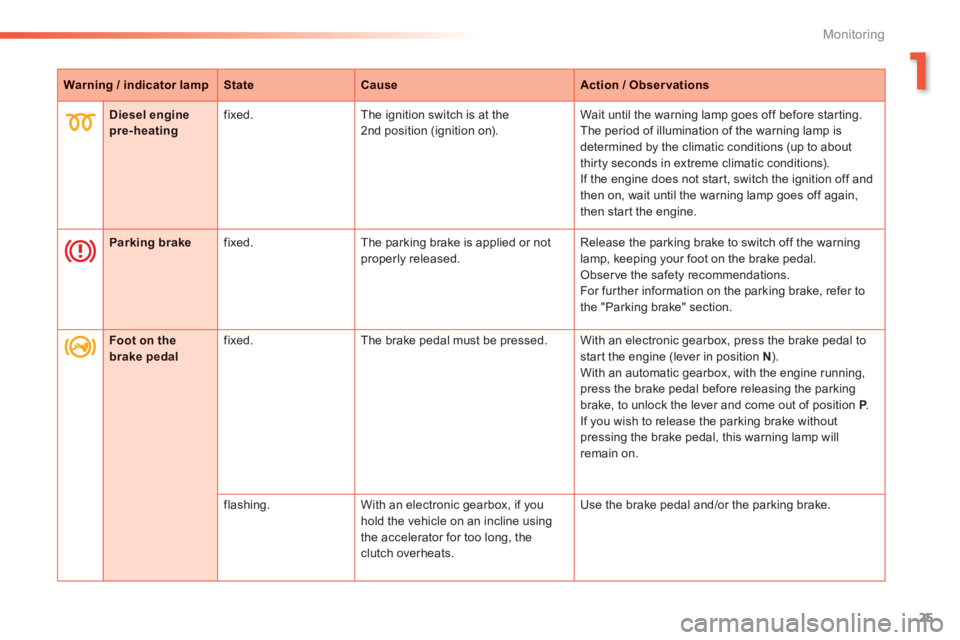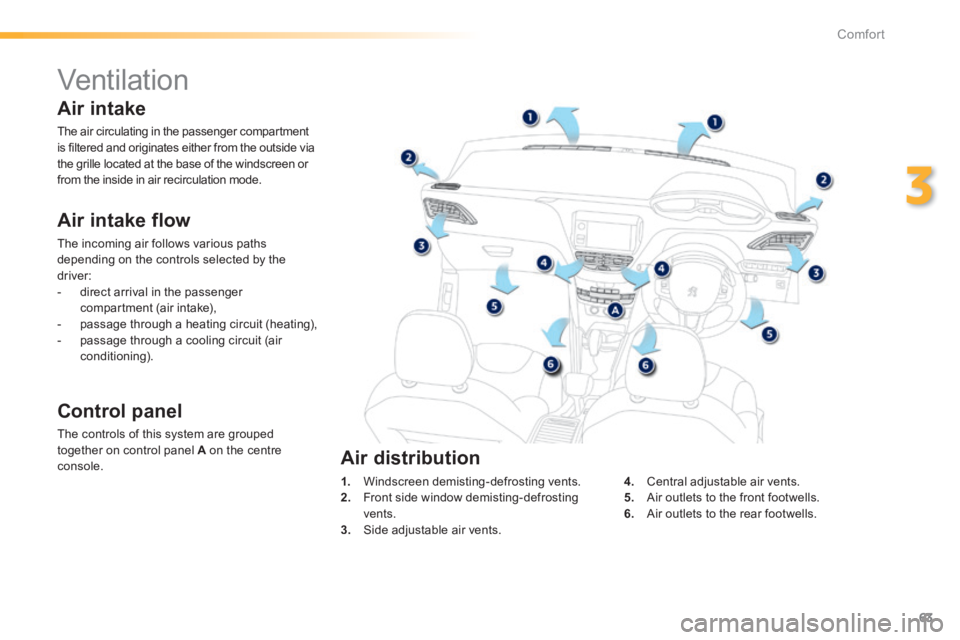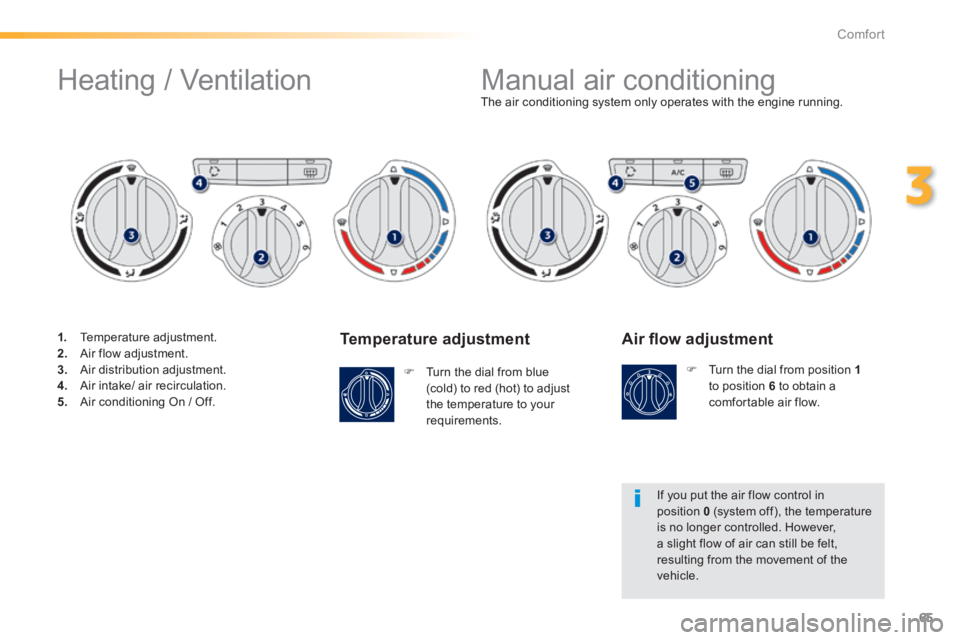2013.5 PEUGEOT 2008 heating
[x] Cancel search: heatingPage 4 of 336

.
.
Contents
Instrument panels 21
Indicator and warning lamps 23
Gauges and indicators 33
Trip computer 38
Trip computer with touch screen 40
Setting the date and time 43
Monitoring
Familiarisation
Remote control key
44
Alarm 51
Electric windows 53
Boot 55
Panoramic sunroof 56
Access
Front seats 57
Rear seats 59
Steering wheel adjustment 60
Mirrors 61
Ventilation 63
Heating 65
Manual air conditioning 65
Dual-zone digital air conditioning 67
Front demist - defrost 70
Rear screen demist - defrost 70
Interior fi ttings 71
Boot fi ttings 75
Comfort
Starting - Stopping the engine 79
Manual parking brake 80
Manual gearbox 81
5-speed electronic gearbox 82
6-speed electronic gearbox 85
Automatic gearbox 89
Gear shift indicator 92
Stop & Start 93
Hill start assist 96
Speed limiter 97
Cruise control 99
Parking sensors 102
Park Assist 104
Driving
Lighting controls 108
LED lamps 112
Daytime running lamps 112
Automatic illumination of headlamps 114
Headlamp adjustment 115
Cornering lighting 116
Wiper controls 117
Automatic rain sensitive wipers 119
Courtesy lamps 121
Interior mood lighting 122
Visibility
Eco-driving
Page 10 of 336

8Familiarisation
11. Front side window demisting/defrosting vent. 12 . Instrument panel. 13. Windscreen demisting/defrosting vent. 14 . Sunshine sensor. 15. Glove box / Passenger's airbag deactivation. 16. Passenger's airbag. 17. Multifunction screen / Audio system. 18. Central adjustable air vents. 19. Central locking and hazard warning buttons.
Instruments and controls
1. Cruise control / speed limiter controls. 2. Steering mounted controls for the touch screen. 3. Wiper / screenwash / trip computer stalk. 4. Lighting and direction indicator stalk 5. Bonnet release lever. 6. Steering wheel adjustment control. 7. Driver's airbag. Horn. 8. Headlamp height adjustment. 9. Switch panel. 10. Side adjustable air vents.
20. Heating / air conditioning controls. 21. 12 V accessory socket. USB port / auxiliary socket. Additional USB port. 22. Open storage. Cup holder. 23. Gear lever. 24. Grip control switch. 25. Parking brake. 26. Panoramic sunroof blind opening and closing control. 2 7. Closed storage compartment. 28. Rear 12 V socket.
Page 16 of 336

14
Familiarisation
I require...
Heating or Manual air conditioning
Air distributionAir flowAir recirculation/Intake of exterior airTemperatureManual AC
HOT
COLD
DEMISTING DEFROSTING
Ventilation
Recommended interior settings
Digital air conditioning: use the automatic mode in preference by pressing the "AUTO" button.
Page 27 of 336

1
25
Monitoring
Warning / indicator lampStateCauseAction / Observations
Diesel engine pre-heating fixed. The ignition switch is at the 2nd position (ignition on). Wait until the warning lamp goes off before starting. The period of illumination of the warning lamp is determined by the climatic conditions (up to about thirty seconds in extreme climatic conditions). If the engine does not start, switch the ignition off and then on, wait until the warning lamp goes off again, then start the engine.
Parking brake fixed. The parking brake is applied or not properly released. Release the parking brake to switch off the warning lamp, keeping your foot on the brake pedal. Observe the safety recommendations. For further information on the parking brake, refer to the "Parking brake" section.
Foot on the brake pedal fixed. The brake pedal must be pressed. With an electronic gearbox, press the brake pedal to start the engine (lever in position N ). With an automatic gearbox, with the engine running, press the brake pedal before releasing the parking brake, to unlock the lever and come out of position P . P . PIf you wish to release the parking brake without
pressing the brake pedal, this warning lamp will remain on.
flashing. With an electronic gearbox, if you hold the vehicle on an incline using
the accelerator for too long, the clutch overheats.
Use the brake pedal and/or the parking brake.
Page 65 of 336

63
3
Comfort
Ventilation
Air intake flow
The incoming air follows various paths depending on the controls selected by the driver: - direct arrival in the passenger compartment (air intake), - passage through a heating circuit (heating), - passage through a cooling circuit (air conditioning).
Control panel
The controls of this system are grouped together on control panel A on the centre console. 1. Windscreen demisting-defrosting vents. 2. Front side window demisting-defrosting vents. 3. Side adjustable air vents.
4. Central adjustable air vents. 5. Air outlets to the front footwells. 6. Air outlets to the rear footwells.
Air distribution
Air intake
The air circulating in the passenger compartment is filtered and originates either from the outside via the grille located at the base of the windscreen or from the inside in air recirculation mode.
Page 66 of 336

64
Comfort
In order for these systems to be fully effective, follow the operation and maintenance guidelines below: To obtain an even air distribution, take care not to obstruct the exterior air intake grilles located at the base of the windscreen, the nozzles, the vents and the air outlets, as well as the air extractor located in the boot. Do not cover the sunshine sensor, located on the dashboard; this is used for regulation of the air conditioning system. Operate the air conditioning system for at least 5 to 10 minutes, once or twice a month to keep it in per fect working order. Ensure that the passenger compartment filter is in good condition and have the filter elements replaced regularly. We recommend the use of a combined passenger compartment filter. Thanks to its special active additive, it contributes to the purification of the air breathed by the occupants and the cleanliness of the passenger compartment (reduction of allergic symptoms, bad odours and greasy deposits). To ensure correct operation of the air conditioning system, you are also advised to have it checked regularly as recommended in the warranty and maintenance record. If the system does not produce cold air, switch it off and contact a PEUGEOT dealer or a qualified workshop. When towing the maximum load on a steep gradient in high temperatures, switching off the air conditioning increases the available engine power and so improves the towing ability.
Recommendations for ventilation and air conditioning
If after an extended stop in sunshine, the interior temperature is very high, first ventilate the passenger compartment for a few moments. Put the air flow control at a setting high enough to quickly change the air in the passenger compartment.
The air conditioning system does not contain chlorine and does not present any danger to the ozone layer.
The condensation created by the air conditioning results in a discharge of water under the vehicle which is per fectly normal.
Stop & Start
The heating and air conditioning systems only work when the engine is running. To maintain a comfortable temperature in the passenger compartment, you can temporarily deactivate the Stop & Start system (see the corresponding section).
Page 67 of 336

65
3
Comfort
Temperature adjustment
Turn the dial from blue (cold) to red (hot) to adjust the temperature to your requirements.
The air conditioning system only operates with the engine running.
Air fl ow adjustment
Turn the dial from position 1to position 6 to obtain a comfortable air flow.
If you put the air flow control in position 0 (system off), the temperature is no longer controlled. However, a slight flow of air can still be felt, resulting from the movement of the vehicle.
Manual air conditioning
Heating / Ventilation
1. Temperature adjustment. 2. Air flow adjustment. 3. Air distribution adjustment. 4. Air intake/ air recirculation. 5. Air conditioning On / Off.
Page 70 of 336

68
Comfort
A setting around 21 enables you to obtain an optimum level of comfort. Depending on your requirements, a setting between 18 and 24 is usual. In addition, it is recommended that you avoid a left /right setting difference of more than 3.
On entering the vehicle, if the interior temperature is much colder or warmer than the comfort value, there is no need to alter the value displayed in order to obtain the required level of comfort. The system corrects the temperature difference automatically and as quickly as possible.
Automatic visibility programme
For maximum cooling or heating of the passenger compartment, you can exceed the minimum value of 14 or the maximum value of 28. Push the switch 2 or 3 down until "LO" is displayed or up until "HI" is displayed.
See "Front demisting-defrosting".
Depending on your requirements, you can make a different selection from that offered by the system by changing a setting. The other functions will still be controlled automatically.
Resuming manual control
The air conditioning is designed to operate efficiently in all seasons, with the windows closed.
Air conditioning On/Off
It allows you: - in summer, to lower the temperature, - in winter, above 3 °C, to improve demisting.
Switching on Press the "A/C" button, the associated indicator lamp comes on. The air conditioning cannot operate when the air flow is set to off.
Switching off Press the "A /C " button again; the associated indicator lamp goes off. Switching off may cause some problems (humidity, misting).
When you modify a setting, the indicator lamp in the "AUTO" button goes off. Press the "AUTO" button again to return to the automatic comfort programme.
Temperature adjustment
The driver and front passenger can each set the temperature to suit their requirements. The value indicated in the screen corresponds to a level of comfort and not to a temperature in degrees Celsius or Fahrenheit.
Press the button 2 or 3 down (blue) reduce the value or up (red) to increase it.